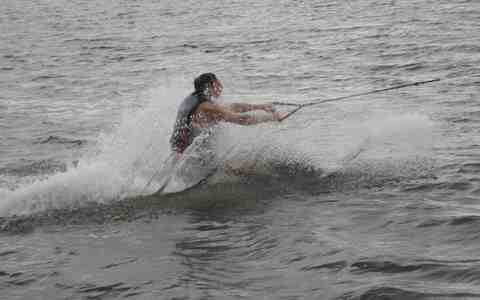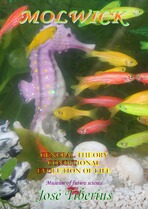2.c) The freedom of living beings
The origin of living beings can be engaging in a personal context. However, it is not relevant for the exposition or validation of the Conditional Evolution of Life’s scientific aspects.
“A Spanish group describes the purest form of life.
How many genes could sustain life? Perhaps 395 are enough. Buchnera was a bacterium of free life and very similar to Escherichia coli, the most common microbes of the human intestine. The comforts of symbiotic life have made it lose 85% of its genes since then.
Buchnera is now halfway between a bacterium and an integral component of the cells of plant louse.”
El País 19-03-2001. Proceedings of the National Academy of Sciences
Energy, or gravity itself, could the origin of living beings if they had some degrees of freedom so small that we would not have the means of perceiving them. Therefore, we would not have another alternative than to include in the corresponding model of scientific behavior random components derived from the gods of science Ale and Hator.
Another example is that we cannot perceive the plants' suffering when they die, and we assume that plants do not like it at all.
We could say the same about small animals.
Nonetheless, the broad concept of life allows the mind to meditate about the evolutionary system's goals with a higher degree of trust in applied logic. In short, what would we do in its place? Of course, Life would have done anything imaginable and much more.
“Ethology
Some animals display democratic behavior in groups. According to a new study, when the deer stand up and the bees dance, they are not merely stretching their legs or indicating where the nectar is. As strange as it seems, they are voting whether to move to greener fields or better-off flowers. Scientists state that the process is subconscious.”
El País 26-02-2003. Nature
The above concept of Life lets to overcome anthropological positions or biological reductionism.
To be precise, regarding positions such as:
Man is the only rational being (Plato - Aristotle)
He is a political animal (Aristotle)
He is unique for possessing the gift of language.
He is unique for creating (not using) instruments (Paleontology.)
He is unique for transmitting his culture (Behaviorism –learning in contrast to instinct)
Necessary laws govern nature and the cosmos, but only the man has freedom.
Man is an animal, and in this sense, everything is instinct, that is, the biological pre-determinism. To a certain extent, it is a result of Darwin’s contribution (Innatism.)
“In the majority of the trials (carried out in pairs) in which a service or exchange does not follow the rules of justice, the primates end the conflict. At times, they rebel by throwing the object of the trial or the received trophy up into the air.”
El País 18-09-2003. Nature
From a scientific or philosophical point of view, human beings are just beings with particular traits, but with living beings' general characteristics and intrinsic to Life.
Ethnocentrism, cultural relativism, and universalism forget about this last aspect since they refer to the human being with unique characteristics without specifying them concerning the rest of the living creatures.
This philosophical approach would assume all beings are living beings. However, we will continue using the standard definition referred only to plants and animals, given that it is a relevant term to speak about genetics.
2.c.1. Philosophy and theory of Vitalism
2.c.1.a) Vital impulse systems
An adequate philosophical antecedent of Conditional Evolution is the theory of Vitalism.
“Scientific progress and society
The individual genes in each cell are peripheral elements that follow the whole system's developmental process, and yet, each one is responsible for integration decisions.
Living systems
Perhaps it is too futuristic speculation, but I think it is worth considering how we could use genetic information processing principles. We are learning from the study of complex biological systems.”
El País 26-11-1992. Eric H. Davidson
For one reason, the vital impulse systems behave as if they were living beings or have their essential characteristics.
The superior animals are like symbiotic macro-societies of more basic units with a life of their own, like cells.
The problem relates to the complexity of the structure of the brain. Modularity and connectionism are two thoughtful approaches that could easily be complementary.
The following types are by order of intuitive proximity:
The first type of vital impulse systems will be those systems whose components are, in turn, living beings –nation, state, beehive, ecosystems.
NEWS ABOUT THE THEORY OF EVOLUTION“British scientists manage to choose the gender of calves.
Besides being expensive since it implies in-vitro fertilization, scientists are quick to add that the technique does not apply to human beings.”
El País 10-01-1993.
Another type will be the effect of the activity of groups of individuals with a specific purpose. Therefore, the protagonists will not be individuals but the particular object of their actions –economic markets of products.
Internal dynamics of systems derived from partial qualities of the individuals –languages
Any work or objective of a living being will have the same evolutionary dynamics as living beings. While developing and achieving the goal, the relationships and conditions make up a vital impulse system –the evolution of computers, a computer program, or a house's construction.
2.c.1.b) Vitalism and characteristics of living beings
The features commented above would be more or less identifiable, but they will be present in all of them in some way.
It is also possible to distinguish between essential characteristics and those derived from the objectives that all vital impulse systems must-have.

Vital impulse systems should have the following characteristics:
- They should have a decision-making process to choose between different options to achieve their purpose. On the one hand, it will imply the existence of degrees of freedom in the system and, on the other, operative intelligence.
- The system will take the options according to the information available, for which the existence of an archive will be necessary.
- The good faith of the system will exist a priori, and, confidently, it will always have it a posteriori.
The system must be a teleological system, that is, with objectives. Even if these cannot be precisely determined, one should always identify the intermediate targets and the methods, processes, and specific instruments for obtaining them.
The objectives will be:
- Improvement of efficiency
- Guarantee and certainty
- Internal coherence and compatibility
- Optimization of the resources
If a system complies with the characteristics, it should behave as if it had a genuine vital impulse.
Besides living beings, a practical method of identification of these systems will be to check:
Systems conceptually delimited according to the proposals of the theory of chaos.
Systems had behavioral or evolutionary graphics with fractal forms. It would not be surprising if the fractal structure had the shape of an arrow tip; the interpretation of this shape would give some clues about the system's purpose or objectives.
